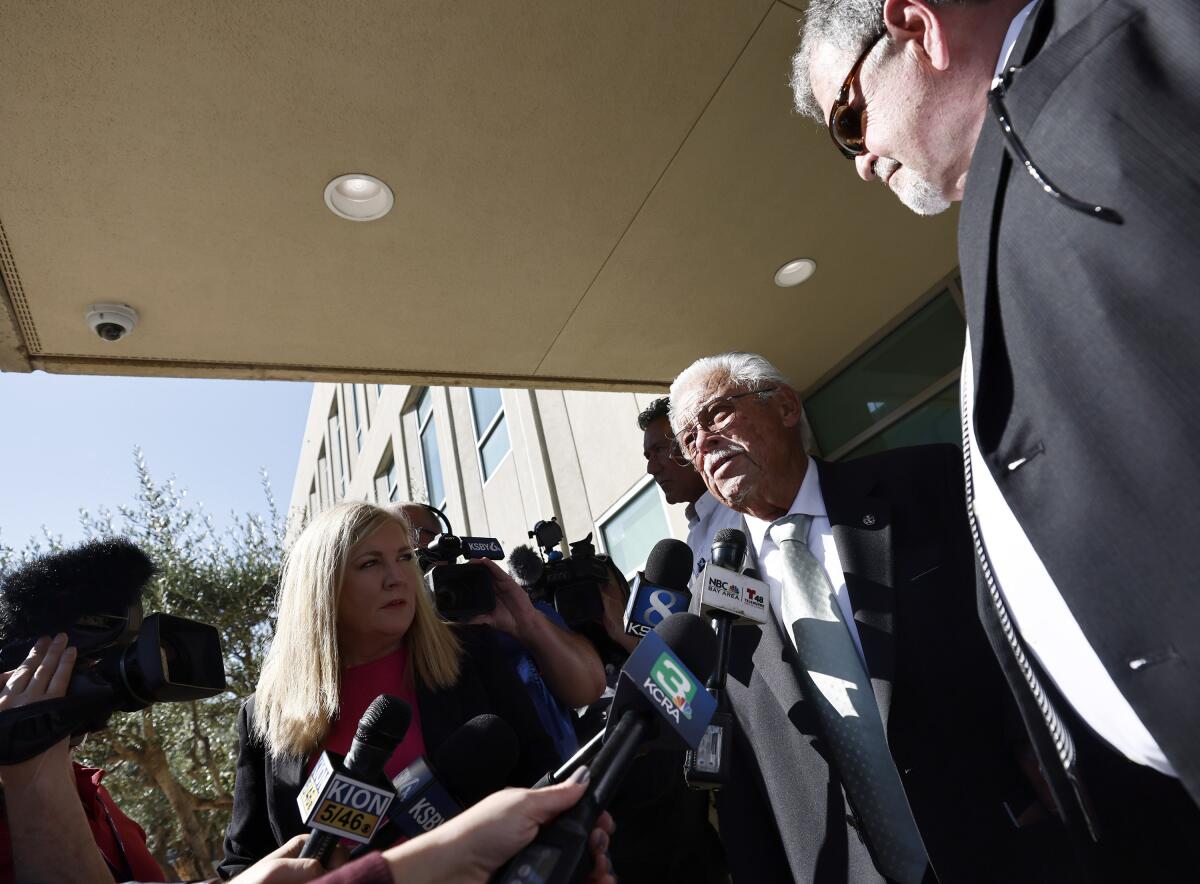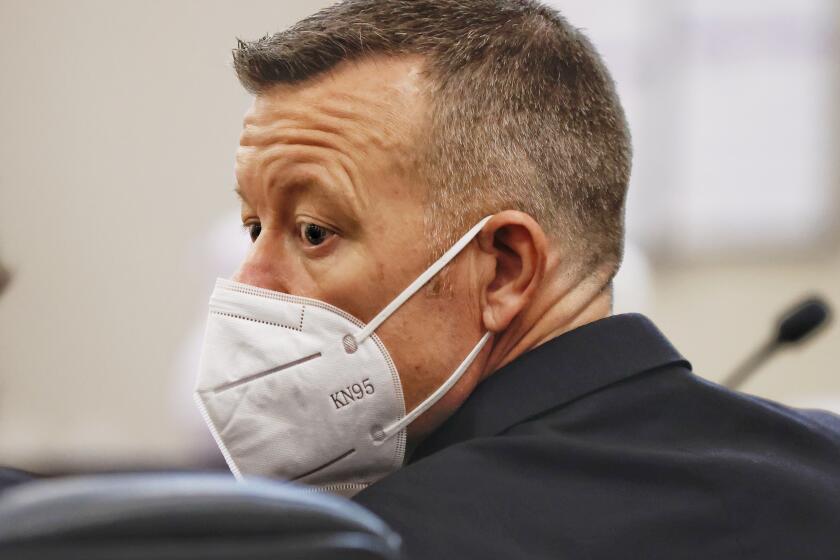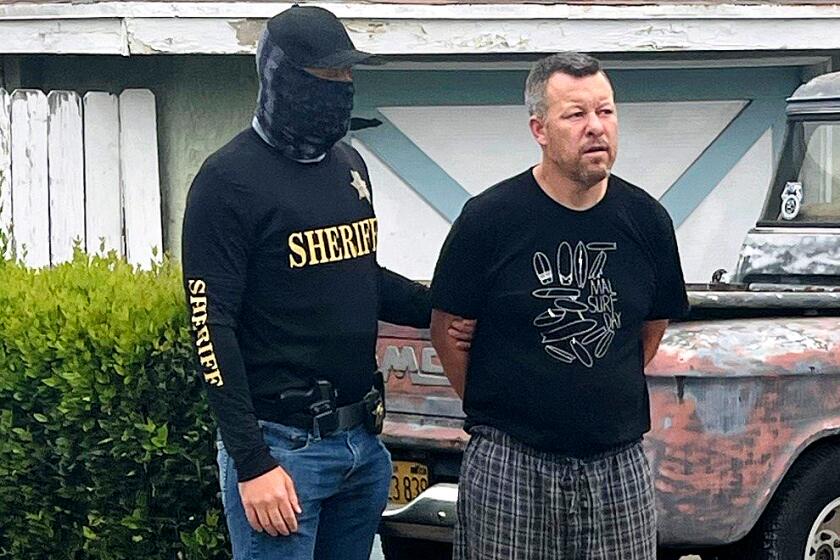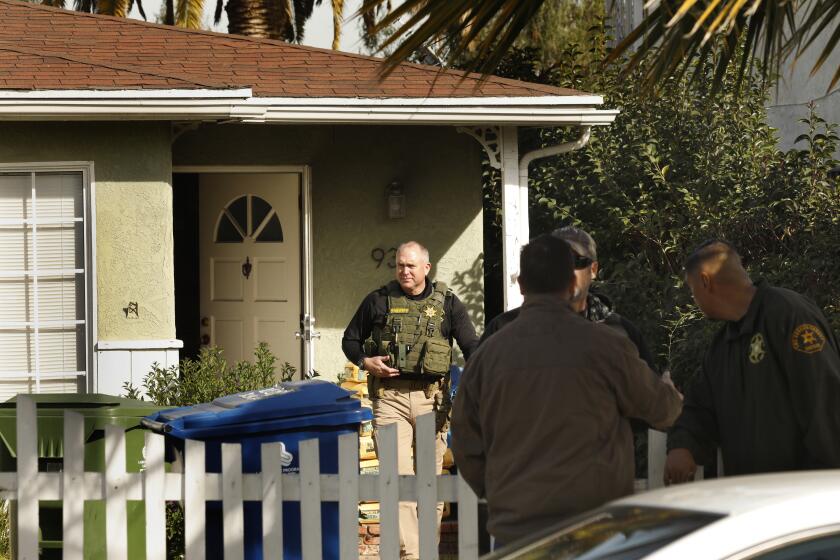Split verdict in Kristin Smart murder: Why Paul Flores was found guilty but not his dad

- Share via
In a courtroom in Salinas, Calif., on Tuesday, a jury rendered a verdict in one of California’s most enduring murder mysteries.
The panel found Paul Flores guilty of first-degree murder in the death of Cal Poly San Luis Obispo student Kristin Smart, who went missing more than two decades ago but whose body has never been found.
Minutes later, a second jury acquitted his father, Ruben Flores, of charges that the 81-year-old helped his son cover up the crime.
While both cases were presented in the same courtroom, they were different in many ways, which could account for the different verdicts.
Prosecutors in the Kristin Smart murder trial turn to graphic images and testimony from two women who testified Paul Flores raped them.
Here is a rundown of what the jury learned:
How did prosecutors convict without a body?
Despite multiple searches over the last two decades — including digs on the Cal Poly campus and at Ruben Flores’ home in Arroyo Grande — Smart’s body was never found. She was declared legally dead in 2002.
But prosecutors had other evidence that the jury appears to have found compelling.
During the trial, San Luis Obispo County Deputy Dist. Atty. Chris Peuvrelle alleged that Paul Flores raped or attempted to rape — and eventually killed — Smart before hiding her remains under a deck at his father’s home. A neighbor reported strange activity with a trailer in Ruben Flores’ yard in 2020, Peuvrelle told jurors. That was when father and son moved Smart’s remains as investigators made new inquiries about the property, he said.
Though no remains have been recovered, prosectors had another key piece of evidence, something that may have proved key in their case. Two women claimed Paul Flores had raped them decades after Smart vanished, supporting the prosecution’s theory that he sexually assaulted the coed, then killed her and hid her body.
Jurors also heard from two women — Sarah Doe and Rhonda Doe — who testified that Flores drugged and raped them decades after Smart vanished. The women, who took the witness stand last month under pseudonyms to protect their privacy, testified that Flores sexually assaulted them in Los Angeles in 2008 and 2011, respectively.
In their cases, Peuvrelle noted that Flores had offered to give the women rides home after meeting them, only to allegedly drug and repeatedly rape them at his house.
Paul Flores is charged in the 1996 disappearance of Kristin Smart, with prosecutors alleging he killed the 19-year-old as he raped or tried to rape her.
What do prosecutors say happened to Smart?
Smart was 19 when she vanished on May 25, 1996, after walking toward the college dormitories with Flores, a fellow Cal Poly student, after a party.
She had arrived at the Crandall Street house party about 10:30 p.m., according to testimony during the trial. Others who were there said she never smelled of alcohol but was seen with one drink shortly before midnight after hanging out with Flores. Afterward, she passed out on a lawn for two hours. Peuvrelle alleged that her behavior was consistent with someone drugging her.
As she and two other students began to leave, Flores appeared out of the darkness to help her walk home, witnesses testified. Smart needed help to get up a hill, and once in sight of the dormitories, prosecutors say, Flores promised to get her home. He later insisted he left her within sight of her dorm.
The weekend that Smart went missing, the prosecution said, the whereabouts of neither Paul Flores nor Ruben Flores could be verified, but Paul Flores called his father and they talked for seven minutes the morning after the event.
Prosecutors alleged father and son made plans to hide Smart’s body, eventually burying it in Ruben Flores’ yard.
But Ruben Flores denied this.
“They’ve had searches and everything,” he said. “They come to my house and say she was buried here, and that’s a surprise to me. They say I dug her up. I am 81 years old, you know. I don’t do too much digging.”
Despite numerous investigations, searches and legal procedures, it took 24 years for an arrest to be made in the disappearance of Kristin Smart.
What was the case against Ruben Flores?
The case again Ruben Flores, who was accused of being an accessory, appeared harder to prove.
Prosecutors alleged he kept people away from his deck for years.
A soil scientist and archaeologist testified that ground radar showed an anomaly and indications of fluids that were consistent with a body having been buried and removed, Peuvrelle repeatedly reminded jurors.
The question of whether Smart was buried at the home and what role Ruben Flores played was debated at trial.
Prosecutors pointed to what they said was hole on the property, 6 feet by 4 feet by 4 feet. Archaeologist Cindy Arrington, Peuvrelle noted, said that the hole was dug by hand and that fluid had leaked into the soil slowly, creating a bath-like ring.
The father of murder suspect Paul Flores is charged with accessory. Two juries are deciding the men’s fate.
Showing slides from a PowerPoint presentation, Peuvrelle said that a chemical test by an independent lab showed a positive result for the presence of human blood in the soil and that fibers recovered from the soil matched the colors of Smart’s clothing.
Harold Mesick, Ruben Flores’ attorney, said expert defense witnesses indicated that the blood test was invalid for soil. He said there would have been gallons of liquid had a body been there.
“The amount of blood is so minuscule ... it could be anyone’s blood. It could be Ruben Flores’ blood,” he said. “I am going to tell you it is not Kristin Smart’s blood.”
Ultimately, the elder Flores said the case “was about feelings; it wasn’t about facts.”
Speaking outside the courthouse after the ankle monitor he had worn for 18 months was removed, Ruben Flores said, “I think that’s what happened with my son. They were carried away with feelings about their family and the girl missing.”
More to Read
Sign up for Essential California
The most important California stories and recommendations in your inbox every morning.
You may occasionally receive promotional content from the Los Angeles Times.


















